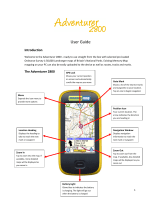
Table of Contents
Introduction.....................................................................1
Device Overview......................................................................... 1
Battery Information..................................................................... 1
Maximizing Battery Life.......................................................... 1
Turning On Battery Save Mode............................................. 1
Long-Term Storage................................................................ 1
Installing AA Batteries.................................................................1
Installing a NiMH Battery Pack................................................... 1
Charging the Battery Pack..................................................... 1
Turning On the Device................................................................ 2
Buttons........................................................................................2
Acquiring Satellite Signals.......................................................... 2
Using the Main Pages.................................................... 2
Opening the Main Menu............................................................. 2
Map............................................................................................. 2
Changing the Map Orientation............................................... 2
Measuring Distance on the Map............................................ 2
Map Settings.......................................................................... 2
Compass.....................................................................................3
Calibrating the Compass........................................................3
Using the Compass................................................................3
Course Pointer....................................................................... 3
Navigating with Sight 'N Go................................................... 3
Trip Computer............................................................................. 3
Trip Computer Settings.......................................................... 3
Elevation Plot.............................................................................. 3
Elevation Plot Settings........................................................... 3
Calibrating the Barometric Altimeter...................................... 4
Restoring Default Page Settings................................................ 4
Waypoints, Routes, and Tracks.................................... 4
Waypoints................................................................................... 4
Creating a Waypoint.............................................................. 4
Projecting a Waypoint............................................................ 4
Navigating to a Waypoint....................................................... 4
Editing a Waypoint................................................................. 4
Deleting a Waypoint............................................................... 4
Routes........................................................................................ 4
Creating a Route.................................................................... 4
Editing the Name of a Route.................................................. 4
Editing a Route...................................................................... 4
Viewing a Route on the Map.................................................. 4
Deleting a Route.................................................................... 4
Navigating a Saved Route..................................................... 4
Viewing the Active Route....................................................... 4
Stopping Navigation............................................................... 4
Reversing a Route................................................................. 4
Tracks......................................................................................... 5
Tracks Settings...................................................................... 5
Viewing the Current Track..................................................... 5
Saving the Current Track....................................................... 5
Clearing the Current Track.....................................................5
Deleting a Track..................................................................... 5
Navigating a Saved Track...................................................... 5
Purchasing Additional Maps....................................................... 5
Finding an Address................................................................ 5
Main Menu Features and Settings................................ 5
Geocaches..................................................................................5
Downloading Geocaches Using a Computer......................... 5
Navigating to a Geocache......................................................5
chirp™....................................................................................5
Sending and Receiving Data Wirelessly..................................... 5
Setting a Proximity Alarm........................................................... 6
Selecting a Profile....................................................................... 6
Area Calculation
......................................................................... 6
Calculating the Size of an Area............................................. 6
Satellite Page..............................................................................6
GPS Satellite Settings............................................................6
Garmin Adventures..................................................................... 6
Sending Files to BaseCamp.................................................. 6
Creating an Adventure........................................................... 6
Starting an Adventure............................................................ 6
Using the VIRB® Remote........................................................... 6
Waypoint Averaging....................................................................6
Pairing a Smartphone with Your Device..................................... 7
Connected Features.............................................................. 7
Phone Notifications................................................................ 7
Garmin Explore...................................................................... 7
Additional Main Menu Tools....................................................... 7
Customizing the Device................................................. 7
Customizing the Data Fields....................................................... 7
Data Fields............................................................................. 7
System Settings.......................................................................... 8
Satellite Settings.................................................................... 9
Serial Interface Settings......................................................... 9
Display Settings.......................................................................... 9
Bluetooth Settings.......................................................................9
Adjusting the Backlight Brightness............................................. 9
Setting the Device Tones............................................................9
Marine Settings........................................................................... 9
Setting Up Marine Alarms...................................................... 9
Resetting Data............................................................................ 9
Changing the Page Sequence.................................................... 9
Adding a Page..................................................................... 10
Removing a Page................................................................ 10
Customizing the Main Menu..................................................... 10
Changing the Units of Measure................................................ 10
Time Settings............................................................................ 10
Position Format Settings...........................................................10
Altimeter Settings......................................................................10
Routing Settings....................................................................... 10
Profiles...................................................................................... 10
Creating a Custom Profile.................................................... 10
Editing a Profile Name......................................................... 10
Deleting a Profile..................................................................10
Device Information....................................................... 11
Product Updates....................................................................... 11
Setting Up Garmin Express................................................. 11
Registering Your Device...................................................... 11
Viewing E-label Regulatory and Compliance Information........ 11
Attaching the Carabiner Clip..................................................... 11
Removing the Carabiner Clip............................................... 11
Attaching the Wrist Strap.......................................................... 11
Device Care.............................................................................. 11
Cleaning the Device............................................................. 11
Data Management.................................................................... 11
File Types............................................................................ 11
Installing a Memory Card..................................................... 11
Connecting the Device to Your Computer........................... 12
Transferring Files to Your Device........................................ 12
Deleting Files....................................................................... 12
Disconnecting the USB Cable..............................................12
Specifications............................................................................12
Appendix....................................................................... 12
Garmin Support Center.............................................................12
Turning On the Backlight.......................................................... 12
Optional Accessories................................................................ 12
tempe™............................................................................... 12
Pairing Your ANT+ Sensors................................................. 12
Table of Contents i




















